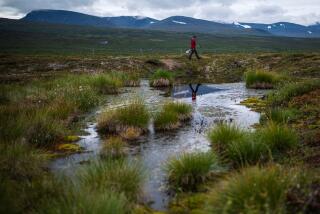SCIENCE / MEDICINE : Thinning Ice Pack May Be Result of Greenhouse Effect : Warming: Figures compiled by submarines show Arctic segment shrank 15% between ’76 and ’87. Researchers say data is inconclusive, but more numbers will be coming in.
- Share via
A large section of the floating Arctic ice pack north of Greenland shrank by 15% between 1976 and 1987, a possible sign of global warming caused by the greenhouse effect, a British researcher reported last week.
That conclusion is based on sonar measurements of the thickness of a California-sized segment of ice pack made in 1987 by a British submarine that retraced the route taken by another submarine that sailed under the ice pack and made similar measurements in 1976.
American researchers termed the new discovery “extremely provocative,” but even the researcher himself, glaciologist Peter Wadhams of the University of Cambridge, cautioned in the journal Nature that it is virtually impossible to draw firm conclusions from only two data points.
That situation may soon be rectified, however. British submarines sailed the same route again in 1988, 1989, and 1990, and Wadhams is now performing the “massive number-crunching” that is necessary to extract the data on the 116,000-square-mile segment.
Unfortunately, those results may not be available until next year. But the results published last week “should provide a good baseline for future studies,” said meteorologist Norbert Untersteiner of the University of Washington in Seattle.
The greenhouse effect is one of the most hotly debated environmental issues. Certain so-called “greenhouse gases” in the atmosphere, particularly carbon dioxide and the chlorofluorocarbons used as refrigerants and solvents, act like the panes of glass in a greenhouse, allowing heat from the sun to penetrate to the Earth’s surface but preventing heat radiated by the Earth from escaping into space.
Since the beginning of the industrial age in the mid-1800s, the concentration of carbon dioxide in the atmosphere has increased by 30% because of increased combustion of fossil fuels, and it is expected to double within 50 to 100 years if fossil-fuel use continues to accelerate. The average global surface temperature has risen by as much as 1.25 degrees Fahrenheit during the same period, and some projections are that it will rise by as much as eight degrees total.
Such an increase in global temperature could make both the United States and Europe hotter and drier, shift temperate growing regions northward and cause melting of the polar ice caps. That melting would cause sea levels to rise, inundating coastal regions around the world, destroying some port cities and rendering some low-level island nations uninhabitable.
Critics of greenhouse warming argue, in contrast, that the initial warming caused by the greenhouse effect would produce greater cloudiness, which would shield the Earth’s surface from sunlight and thereby ameliorate the warming. The Bush Administration has argued in recent global meetings that no action should be taken to reduce carbon dioxide emissions until a much better understanding of the phenomenon is obtained.
Although some oceanographers calculate that the level of the Earth’s oceans has risen by one to three inches since 1850, there is little evidence to indicate that the polar caps might be melting.
The Department of Commerce’s NOAA Corps, a military-style corps that protects the environment, monitors the extent of the global icecaps year-round. “There has not been a statistical study” of changes in the extent of the ice, said Lt. j.g. Josh McDowell of the Corps, “but at a casual glance, there has been no discernible trend.”
Satellite data indicate there has been a thickening of the Antarctic snowpack in recent years, but such a thickening--a result of increased snowfall due to the higher amount of water vapor in warmer air--represents a different phenomenon, Wadhams said in a telephone interview, and is itself also predicted by the greenhouse theory.
The submarines followed a 3,700-mile-long course due north from Greenland, under the pole, and then southward. The major changes in the ice pack occurred in a 248-mile-long, 62-mile-wide segment just north of Greenland. In October 1976, the average thickness of this segment was 17.5 feet. In May 1987, the average was 14.92 feet, a 14.8% decrease in ice volume.
Furthermore, Wadhams said, that stretch of ice pack is normally thicker in May than in October because of buildup from freezing in winter and thinning from thawing during the summer, so the actual decrease may have been even larger.
But Wadhams and others note that the change in thickness could also represent previously unknown cyclic variations in the thickness of the ice pack, or that either of the observations could represent an anomaly that is skewing results.
“The fact is that no data published so far can provide a reliable indication of whether the sea ice in the Arctic Basin is thinning, thickening or remaining essentially constant,” wrote a team headed by oceanographer Albert S. McLaren of the University of Colorado in Boulder in a commentary in the same issue of Nature.
Nonetheless, they added, the new data provides a good place to start to look for trends.






